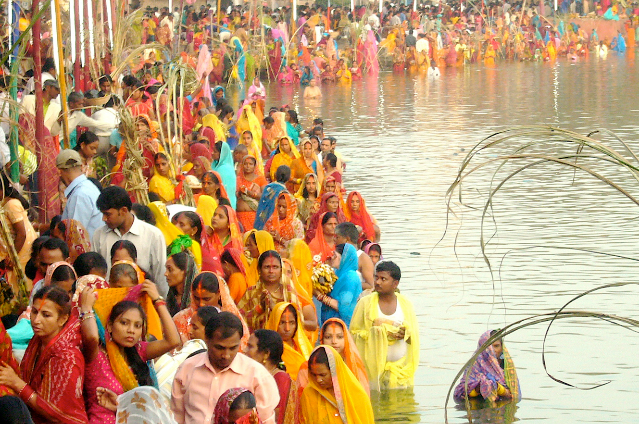We offer you our offerings O sun god, and Chhathi Maiya. One who does this puja, gets a long life, health, and good eyesight. All their wishes get fulfilled! You are the source of our happiness, our prosperity comes from you. You are the source of all the life force and development in all living beings. We bow to thee, please accept our offerings and give us your blessings. O giver of life!
This festival is dedicated to the sun and Chhathi Maiya. The devotee offers their gratitude to the sun god surya along with the goddess Usha and Pratyusha because it is believed that the sun is the primal source of energy that sustains all lives on the earth. This festival is unique to the states of Bihar, Eastern Uttar Pradesh, Jharkhand, and the country Nepal. It is the only festival that is dedicated to Lord Surya, who is supposed to be the source of all powers. The god of light, life force, and energy is worshipped in order to promote the well-being, prosperity, and development of human beings. Devotees express their gratitude toward lord Surya and perform important rituals over a span of four days. People who observed the fast during this festival are called Vrati. It is four days festival which is celebrated with rigorous and strict manners of preparation. So, during the period the devotee lives separately from the rest of the family for maintaining chastity as well as purity.
The prasad and food for devotees are cooked without salt, onions, and garlic which is accomplished and accompanied by four days of preparation. The devotees take bath in the holy water of Ganga and the surrounding house is purified with Ganga Jal water. They take only a one-time meal i.e.Kaddu -bhat which is cooked in the bronze and mud utensils by using mango wood over a mud stove. The devotee hold fast for the whole day and breaks their fast only after worshipping of the sun god in the evening with rasiao kheer, puris, and fruits. After fast rule of breaking they again go for fast without water for the next 36 hours. The devotees offer santhya arghya at the riverside then after they wear turmeric colour sarees. In the night of this day, the devotee celebrates the vibrant events of lling kosi, by lighting clay diyas under ve sugarcane stick with the folk song of chhathi maiya. This sugarcane stick represents the panchatattva i.e. Earth, Air, Water, Fire, and Space.
Then on the nal day of chhath puja the devotees along with family and friends offer bihaniya aragh to the sun god at the riverside. And at lastthe devotees end their fast with chhath puja prasad. In both Nepali and Hindi languages, the word chhath means six.Hence this festival is celebrated on the sixth day of the month of diwali festival (karthika). Therefore, the festival is named chhath.
There are several legends that explain in detail the origin of this festival. It is believed that in ancient times, Draupadi and the pandavas of Hastinapur used to celebrate chhath in order to solve their issues and gain their lost Kingdom again. A few mantras from the rig veda texts are chanted by worshippers while offering prayers to the sun god. As per legend, chhath puja is being performed since the early vedic period. The legend has it that the sages of that era used to perform the puja by exposing themselves to direct sunlight to gain energy from the rays of the sun and did not consume any eatables.
Chhath puja is an important festival and is celebrated with a lot of dedication by the devotees. Culturally, the essential feature of this tradition and festival is its simplicity, love of nature, and purification of the mind, body, and soul. There is a belief that the devotees who do chhath puja keeping in view all the rituals get their desired wish fulfilled by the Chhathi Maiya.

